Spam filters, techniques and how to avoid email hitting spam filters?
Published on 2020-05-08· Updated on 2021-12-15
Introduction
A spam filter is a method of processing emails and segregating those emails into categories. Depending on the types it decides whether to proceed with a further procedure to inboxing, discarding or moving the email to the spam folder. A spam filter concept is similar to a process of dividing a substantial amount of data into chunks and then removing unwanted vague data.
Mail filters organize the incoming mails or remove Spam or unwanted emails that have been injected or send from the current email server. These filters are implemented almost at every organization to keep their people and data safe from unwanted emails.
In this tutorials, you will learn A-Z of email spam filters and steps to avoid your emails hitting the spam filters.

FAQ
- What is Spam filter?
- How does spam filter work?
- Spam filtering techniques
- Why spam filtering is important?
- How to avoid Spam filters?
What is Spam Filter?
Knowing what spam email is, is not enough but how these spam emails are different from the other emails is something you should learn. Detecting spam emails and moving to them to spam folders seems to be magic, but the real challenge and topic of interest are how to inbox more and avoid Spam.
A spam filter detects the nature of emails by parsing the content of the email body which can have unwanted, malicious or unsolicited data and accordingly move to the spam folder and prevents inboxing.
Spam filters are used by every ISP (Internet service provider) to keep their customers away from Spam. Spam filtering is implemented on both side, i.e. On incoming emails, also known as inbound emails and the emails going outside the network, also known as outbound emails.
Right from small to large-sized companies, everyone has their spam filters to avoid Spam and malware within the network.
How does spam filter work?
Spam filters use decision-making algorithms which parses every email and assigns a number. This number is calculated based on the set of rules which these algorithms use to parse email. The number is the probability of email as spam-related content. Once this number crosses the threshold, these emails are automatically marked as Spam. The number is also known as a spam score for an email.
Spam score depends on various parameters not just the content of the email, like the email server used to send emails, IP and domain reputation.
Spam filtering techniques
As you have seen above, a few techniques for spam filtering, which is based on content, IP, header and some custom rules. Let us see a few more spam filtering methods which are as follows:
- Filters based on List: This technique is used for dividing the list into multiple small lists such as spammers, authentic users or blocking the emails from specific source accordingly.
- Filters on Content: Email contents should be clean, concise and have small images (width of 600-800 pixels). Many Internet service providers have an aggressive spam filter, which is marked as Spam based on pictures and specific content. The whole email body is parsed and its searches for spam trigger words like "FREE", "You're a Winner" or "You have Won $1,234,000".
So, there is not any specific rule but is recommended not to use additional content and images. And there should be a 65-35% text-to-images ratio. - Filters for Blacklisting: This filter will block all the emails from blacklisted IP source. This filter will check the reputation of IP address on a realtime basis and if anything suspicious found the emails are immediately marked as Spam.
- Filters for Headers: Every email's headers are parsed, and it looks for suspicious information, i.e. From where the email has come and routing information.
- Filters based on custom Rules: Depending on the spam email's history, you can add customized rules for the spam filters like regex on the subject line, from address, domain or a specific range of IPs.
- Realtime blacklist hole: This technique is similar to a vintage blacklist, but since it is on the third parties side, you didn't need to do any kind of maintenance. These third parties take time to build a list of blacklist domain and IPs on behalf of the client.
Whenever the emails are sent to the recipient, they have to look up this realtime blacklist hole every time. - Filters based on Heuristic: This technique is one step ahead of content-based filtering. The method not only compares just words and pictures; instead, it takes care of multiple terms within an email. Depending on the content of emails entering the network, it starts assigning point. For example, while parsing if it matches the words like "Free" or "$", then the highest scores are assigned.
Similarly, there many such words for the scores are assigned, and once the threshold has exceeded, then those emails are marked as Spam and blocked at the email server. This filter is considered one of the fastest way of installing and configuring for minimizing delay in email receiving and delivery. - Bayesian filtering: One of the most advance technique which uses mathematical probability to check the nature of emails whether they are legitimate or Spam. This filter needs to be trained manually by adding marking one by one emails as Spam. Every time, an email is parsed; this filter gets prepared by adding words, phrases to the list.
To determine whether the emails are Spam or not, the Bayesian filter parses the email body and compares words within an email, which further calculates the probability of Spam.
For example: let's assume an email from a particular source that has word "FREE", and you have received such emails about 40 times out of 65 which as word "FREE". So, whenever an email has been received with the same word "FREE" from the same IP, then it will be considered 90% as Spam.
Why spam filtering is important?
Spam filters are necessary because spamming has become one of the business models for spammers; they earn almost $8-$10K per week. Due to which spam filters is a must for your business. It is said that out of 100 emails, around 60-70 of emails are Spam i.e. (70% of emails are spam)
These Spam businesses keep on growing every year because it is has become one of a lucrative business. Spammers are getting more creative with their strategies and techniques to inbox their emails. In order to avoid this spam technique, you must keep updating your spam filters.
The spam filters are very crucial though they don't provide 100% foolproof results but are essential to keep spam away from your business. It is necessary to keep your network free from spams like phishing attacks, malware attachments, malicious web links and viruses. Spam filters help in protecting your email servers a getting overloaded but also keeps spam email away from your users and network.
How to avoid spam filters?
Spam filters can be easily cracked if you follow authentic email practices which are as follows:
Using the Opt-in technique wisely.
Opt-ins are probably the best method to stop a spammer from spamming your database. This method usually allows you to get permission from your recipients. Even Pepipost's Signup forms are by default using a double opt-in process.
This method considers your emails are not spam oriented and must follow all the rules in the CAN-SPAM Act.
Permissions are never assumed.
Don't consider that you have already got permission from your customers or you can send emails to those who know you like your colleagues, friends or people. It is always good practice to get permission from those you are sending emails sharing a form or subscription(opt-in) links.
Your campaigns are a brand extension.
The customers already know you because you have taken the permission before. So don't make your email heavy by adding visual effects and large brand images because these are the common mistakes that cost a lot for your campaign either they are rejected or moved to the spam folder.
Always keep your unsubscribe link visible within your email don't hide it. If the link is visible to the people who no longer want to receive an email, they will opt-out willingly instead reporting your email as Spam.
Avoid purchasing email lists.
Don't try to build your contact list by adding a purchased email list. These lists are scrapped email id which is invalid and does not guarantee any kind of success for your campaign. This also violates the first rule of getting permission from your recipient.
Sending emails to a purchased list leads to high bounce rates and blacklisting of your emails.
Conclusion
Spam filters are just like a firewall for emails which has various set of rules and learning those techniques will help you build your internal email best practice guidelines.
I hope this tutorial was useful in sharing information about spam filters, techniques and ways to avoid them. Feel free to share your experience below in the comments.
Other Related Tutorial.
Grade My Email
Check your spam now?
Netcorecloud's toolkit is the solution to all your email problems.

You can also explore
Netcore connects & unifies your data across all sources, connects to your marketing channels and provides you with control over AI Powered automation and personalization.
Deploy emails that are
screenshot worthy!













Vikram Sahu 🦉
Developer Evangelist, Pepipost
💻 Senior Software engineer → 🥑 Developer Relations guy → 🤓 Building Community for Email Geeks 🎟 → Speaker 🎙